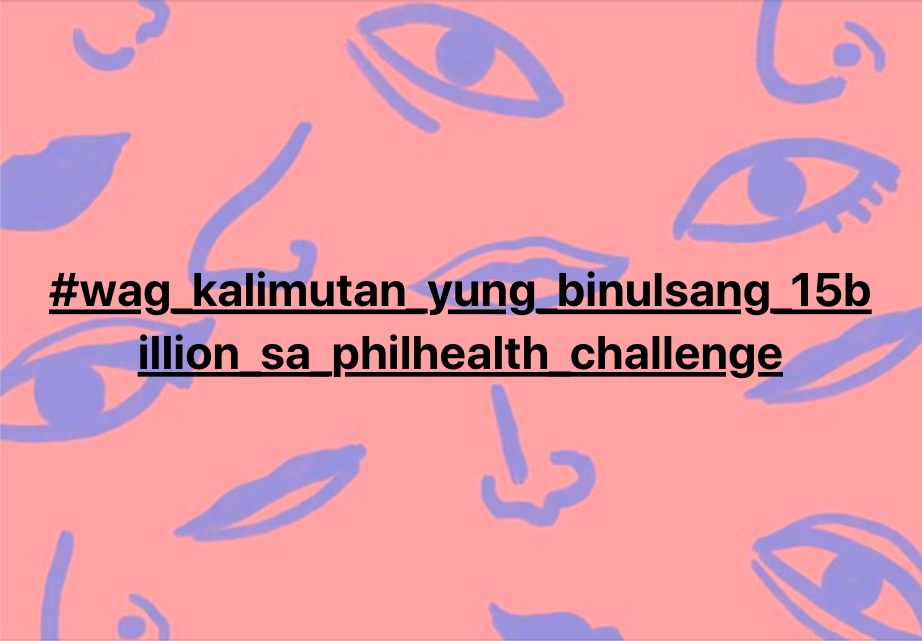Apparently, Facebook can now do hashtags but with underscores for spaces. You might have seen it in recent days through your friends joining a #do_something_challenge. What seemed at first as a mindless trend is now being used by netizens to revisit one of quarantine’s biggest controversies surrounding the embattled Philippine Health Insurance Corporation (PhilHealth) and allegedly billions of pesos pocketed by its officials.
#wag_kalimutan_yung_binulsang_15billion_sa_philhealth_challenge has over 130,000 posts as of writing. But somehow, like most trends or movements that start with a hashtag, this little fire is insufficient to draw enough attention or in this case, recollection of this issue that was brought to light more than a month ago. Beyond the hashtag, for people with a proverbial short-term memory loss who are overwhelmed with the issues constantly being made known to the public—like the recent Manila Bay dolomite rehabilitation—there needs to be a refresher. So, in the spirit of public service, here we will try to give you the “long-story-short” of the PhilHealth corruption controversy.
About that P15 billion
In the first week of August, whistleblower Atty. Thorrsson Montes Keith testified before the Senate to expose the alleged corruption in the country’s health insurance agency.
Keith, who served as PhilHealth’s antifraud legal officer until July this year, said that PhilHealth’s executive committee composed the “mafia” that had allegedly been defrauding the corporation for the past several years.
[READ: PhilHealth’s corruption controversy continues as Palace orders investigation]“I believe, based on my investigation, that the (public) money that had been wasted or stolen was more or less P15 billion,” he said. The claim has since been denied by PhilHealth.
Who are the members of the “mafia”? Another whistleblower in the person of PhilHealth board member Alejandro Cabading later named PhilHealth Senior Vice President (SVP) for legal sector Rodolfo del Rosario, SVP for management services sector Dennis Mas, SVP for fund management sector Renator Limsiaco Jr. and corporate secretary Jonathan Mangaoang.
Even then PhilHealth President and CEO Ricardo Morales, a retired Army brigadier general and a former rebel soldier appointed by President Rodrigo Duterte last year, to solve corruption within the agency, was complicit, said Keith.
According to Keith, Morales asked him to “massage” the Presidential Anti-Corruption Commission’s of the allegedly overpriced testing kits for COVID-19, which he refused to do.
Cabading backed Keith’s claim, adding to the pile of evidence a dubious information technology project priced at P2.1 billion that he had a heated exchange about with Morales a few weeks before the hearing.
According to a Rappler report, the said project included an unspecified number of laptops worth more than P119 million, 43 unspecified “ICT resources” worth P40 million, and 3 unnamed projects for P98 million.
A questionable remedy
After a couple more hearings in the Senate and eventually, in the House of Representatives, which pressed on until early September, Morales eventually stepped down on Aug. 26 citing health reasons. Five days later, Duterte appointed a new PhilHealth President and CEO: former National Bureau of Investigation Director Dante Gierran. The appointment did not proceed without criticism as Gierran himself admitted he had no prior experience in public health services, a requisite qualification under Section 14 of Republic Act 11223 or Universal Health Care.
Over 30 PhilHealth officials are under investigation, according to a separate investigation by the Presidential Anti-Corruption Commission, as of Aug. 11.
According to the latest statement from Presidential Spokesperson Harry S. Roque, “The Department of Justice, through its PhilHealth Task Force, is finalizing the complaints identified in its report to President Rodrigo Roa Duterte for filing before the proper venue.”
But truth be told, by some accounts, including that of Cabading, the P15 billion is just the tip of the iceberg in the agency’s long history of alleged corruption.
Based on a report by Inquirer, whistleblowers estimate that the insurance company lost P154 billion to various types of fraud over the past few years. Such anomalies, according to Rappler’ research, include a cataract surgery scam in 2015, excessive travel allowance for top officials in 2017, and a scandal involving “ghost patients” undergoing kidney treatments, which allegedly started in 2016.
Before leaving his post, Morales said in an Aug. 11 Senate hearing, “Fraud has always been in the system as it has always been in all similar health systems in the world. The problem is systemic and cannot be solved in one year, maybe not even in three years.”
In a country riddled with many issues, one must constantly consciously remember. Occasionally, in the middle of ongoing controversy, another thing pops out of nowhere, as if to distract us—case in point, the other questionable government spending for the “rehabilitation” and beautification of A PORTION OF Manila Bay.
Regurgitating an issue through the use of social media is commendable. But more than that, it should be a recognition of the facts because otherwise, we are no better than trolls leveraging the power of social media.
Get more stories like this by subscribing to our weekly newsletter here.
Read more:
PhilHealth’s corruption controversy continues as Palace orders investigation
How disinformation is a major symptom of a sick democracy
This bill wants to increase politicians’ allowable campaign spending. How will it affect elections?
Writer: CHRISTIAN SAN JOSE




